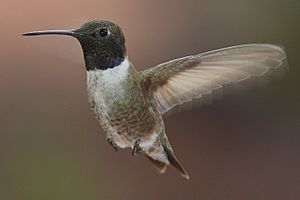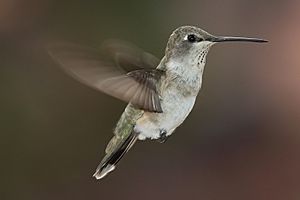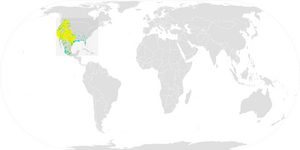Black-chinned hummingbird facts for kids
Quick facts for kids Black-chinned hummingbird |
|
|---|---|
 |
|
| Male | |
 |
|
| Female | |
| Conservation status | |
| Scientific classification | |
| Genus: |
Archilochus
|
| Species: |
alexandri
|
 |
|
| Global range Year-Round Range Summer Range Winter Range | |
The black-chinned hummingbird (Archilochus alexandri) is a tiny bird that lives in many different places. These hummingbirds travel long distances, flying south to Mexico for the winter.
Contents
About Black-Chinned Hummingbirds
What is a Hybrid Bird?
Sometimes, a black-chinned hummingbird can have babies with other types of hummingbirds. This mix creates a "hybrid" bird. It's like having parents from two different species. Black-chinned hummingbirds have been known to create hybrids with Anna's, Lucifer, broad-tailed, and Costa's hummingbirds.
Smallest DNA Code
Did you know that the black-chinned hummingbird has one of the smallest known genomes? A genome is like the instruction manual for a living thing. Their instruction manual is very short compared to most other animals with backbones.
What Do They Look Like?
Black-chinned hummingbirds are about 8.25 centimeters (3.25 inches) long. Their backs are a shiny metallic green. Their bellies are white with green on the sides. They have a long, thin, straight beak.
Male vs. Female
The adult male has a black face and chin. He also has a bright, shiny purple band on his throat. His tail is dark and shaped like a fork.
The female looks a bit different. She does not have the purple throat patch. Her tail is dark and rounded, with white tips. Young hummingbirds look a lot like the adult females. Young males might have a few purple feathers on their throats.
Growing Up
When baby hummingbirds hatch, they have almost no feathers. But they grow a full set of feathers in about three weeks! Young birds start to get their adult feathers around November. They have their first full adult feathers by April or May. After that, they change their feathers once a year.
Similar Birds
It can be tricky to tell black-chinned hummingbirds apart from other hummingbirds. They look similar to the broad-tailed hummingbird, rufous hummingbird, calliope hummingbird, Allen's hummingbird, Lucifer hummingbird, Anna's hummingbird, and Costa's hummingbird.
Where Do They Live?
Black-chinned hummingbirds live in most parts of the western United States. You can find them as far north as Canada in Alberta and British Columbia. They also live east to Oklahoma and south into Mexico.
They like many different places to live. These include mountains, forests, fruit farms, open fields, and areas with thick shrubs. They prefer open, dry places, especially near water, for raising their young.
How Do They Live?
What They Eat
These birds mostly drink nectar from flowers. They use their long tongues to reach the sweet liquid. They also catch small insects while flying. When they drink nectar, they help plants by moving pollen from one flower to another. This is called pollination.
Protecting Their Space
Male and female black-chinned hummingbirds often choose different areas for their nests. They can be very protective of their feeding spots, like bird feeders. They become even more protective during nesting season. However, if there are many birds and lots of food, they might not be as territorial.
These hummingbirds make loud, complex calls to warn others. They also perform amazing diving displays. They dive from 12 to 18 meters (40 to 60 feet) high! As they dive, air rushing through their feathers makes different sounds. They use these dives to protect their territory and to attract mates.
Building a Nest
The female hummingbird builds a very hidden nest. She uses plant fibers, spider webs, and small pieces of lichen to build it. Nests are usually in a bush or tree, about 1.8 to 3.6 meters (6 to 12 feet) off the ground. They often build their nests on branches that stick out.
Interestingly, they sometimes build their nests near the nests of much larger birds that hunt other animals. These big birds are not interested in tiny hummingbirds. But their presence scares away smaller predators that might try to eat the hummingbird's eggs or babies.
The female lays two tiny white eggs, each about 8 millimeters (0.3 inches) wide. She sits on them for 12 to 16 days until they hatch.
Who Hunts Them?
Because they are so small, black-chinned hummingbirds can be hunted by insect-eating birds and other small animals.
Are They Safe?
The black-chinned hummingbird is considered a "least-concern species". This means they are not in danger of disappearing. They live in a very large area, and their numbers are actually growing! Their population has increased by about 14.6% every ten years.
See also
 In Spanish: Colibrí gorjinegro para niños
In Spanish: Colibrí gorjinegro para niños


